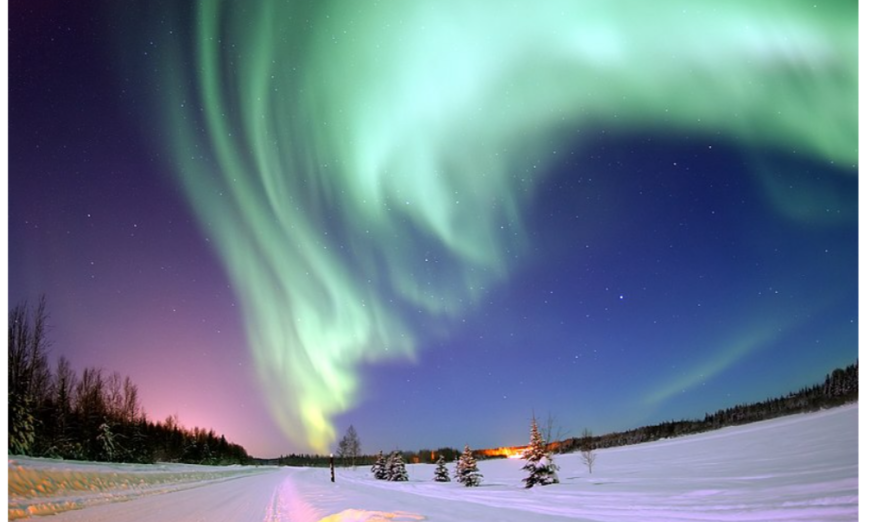These are also called, Southern Lights, The Northern Lights, Borealis, Aurora Australis, Aurora Borealis.
An aurora (plural: auroras or aurorae), also commonly known as the polar lights, is a natural light display in Earth’s sky, predominantly seen in high-latitude regions (around the Arctic and Antarctic).
Auroras display dynamic patterns of brilliant lights that appear as curtains, rays, spirals, or dynamic flickers covering the entire sky.
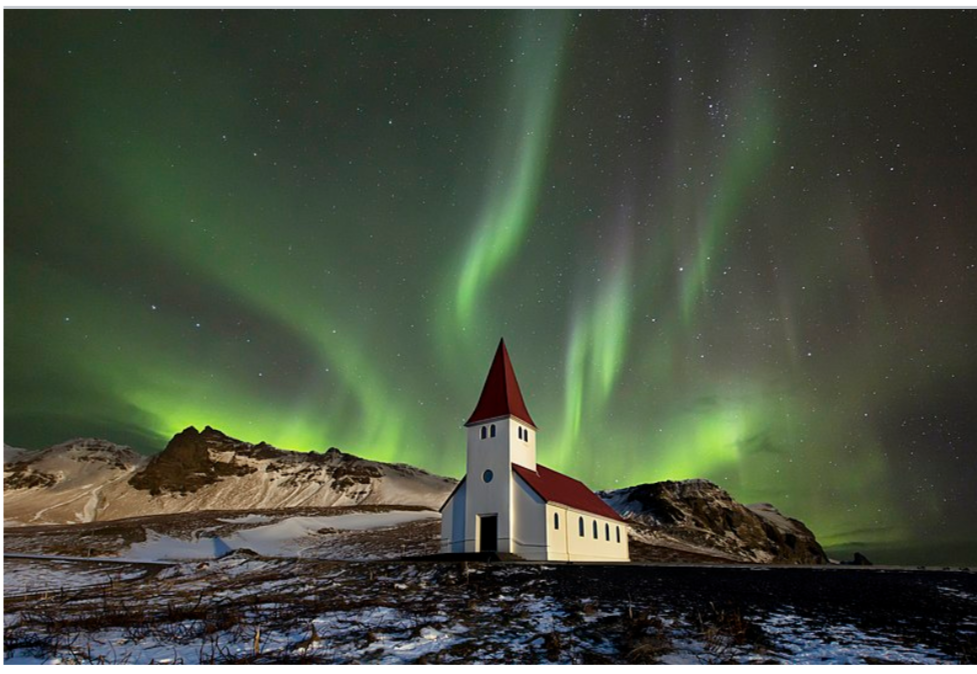
Date, 24 November 2017, 21:41:22
Source, Own work.
Author, AstroAnthony.
In the ionosphere, the ions of the solar wind collide with atoms of oxygen and nitrogen from the Earth’s atmosphere. The energy released during these collisions causes a colorful glowing halo around the poles—an aurora. Most auroras happen about 97-1,000 kilometers (60-620 miles) above the Earth’s surface.

Northern Lights with very rare blue light emitted by nitrogen.
Svenska: Norrsken med mycket ovanligt blått sken i.
Date, 10 October 2010. Source, Own work.
Author, Varjisakka.

This image was released by the United States Air Force with the ID 050118-F-3488S-003.
United States Air Force photo by Senior Airman Joshua Strang.
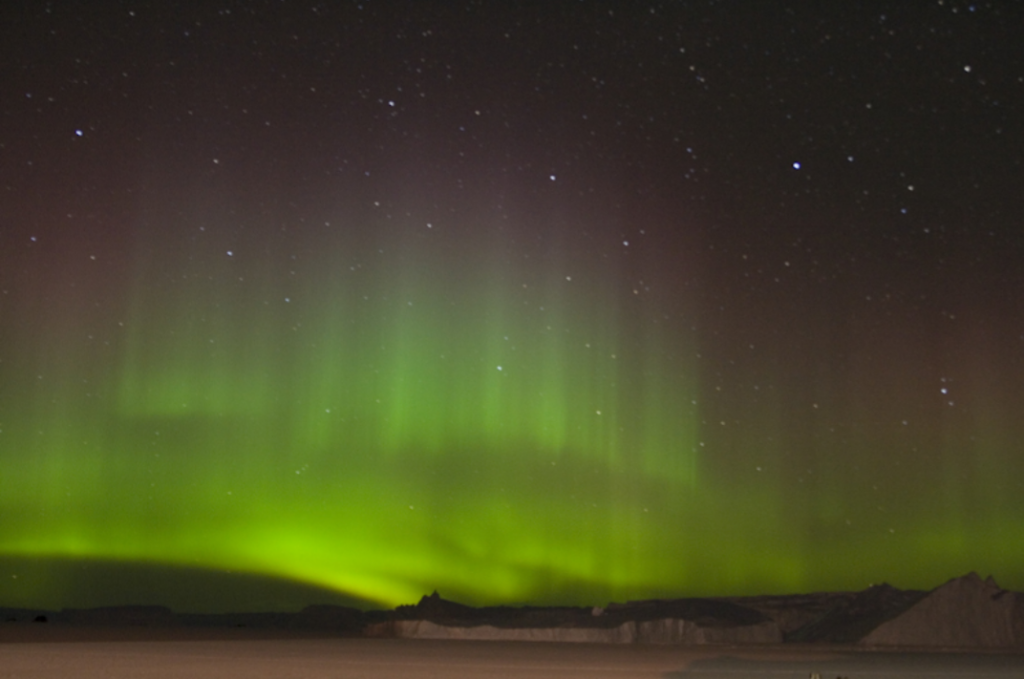
English: Aurora australis in Antarctica
Français : Aurore australe en Antarctique
Date, 22 April 2006.
Source, Own work.
Author, This illustration was made by Samuel Blanc.
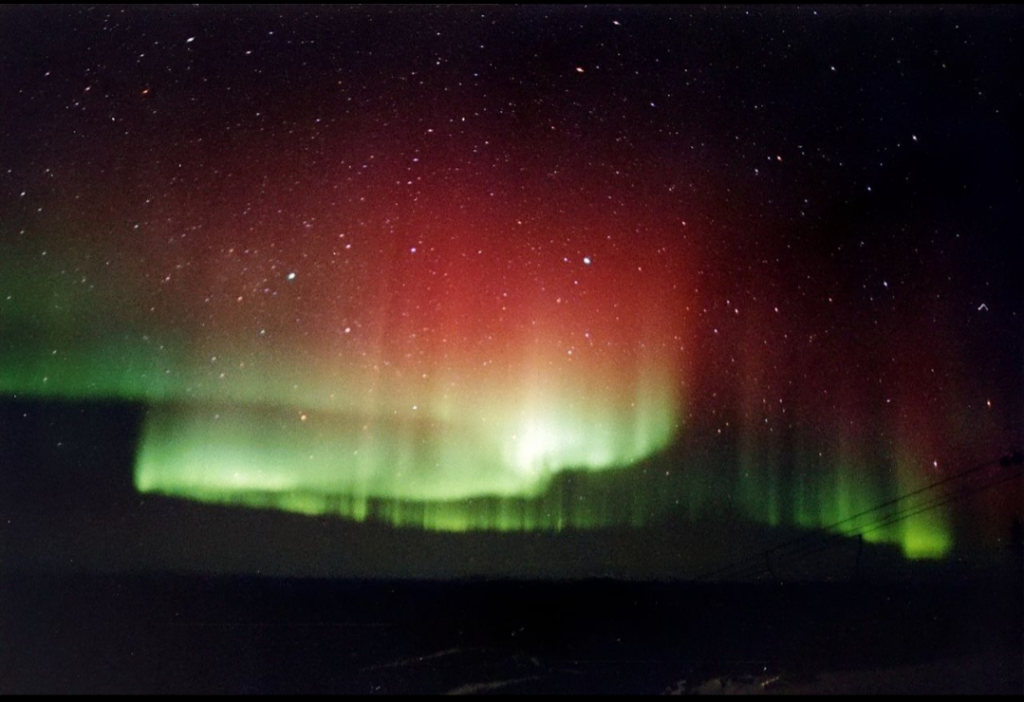
Date, 26 October 2007 (original upload date).
Source, Scan of an old print.
Author, Photograped by Brocken Inaglory.

Auroras are created in the upper atmosphere when the solar wind (a stream of charged particles emitted by the Sun) interacts with the Earth’s protective magnetic field. Charged particles within the magnetosphere are accelerated down field lines toward the ionosphere, where they collide with different gases (particularly oxygen and nitrogen) and emit light as a reaction.
Auroras often appear as neon green, purple, yellow, or red, depending on the gas molecules being excited. Green, for example, indicates collisions with oxygen.
Astronaut photograph ISS052-E-63378 was acquired on August 19, 2017
Author, NASA Astronaut photograph from International Space Station.
Auroras are the result of disturbances in the magnetosphere caused by the solar wind. Major disturbances result from enhancements in the speed of the solar wind from coronal holes and coronal mass ejections. These disturbances alter the trajectories of charged particles in the magnetospheric plasma.
These particles, mainly electrons and protons, precipitate into the upper atmosphere (thermosphere/exosphere). The resulting ionization and excitation of atmospheric constituents emit light of varying colour and complexity. The form of the aurora, occurring within bands around both polar regions, is also dependent on the amount of acceleration imparted to the precipitating particles.
Most of the planets in the Solar System, some natural satellites, brown dwarfs, and even comets also host auroras.
Etymology.
The word “aurora” is derived from the name of the Roman goddess of the dawn, Aurora, who travelled from east to west announcing the coming of the sun.
Ancient Greek poets used the corresponding name Eos metaphorically to refer to dawn, often mentioning its play of colors across the otherwise dark sky (e.g., “rosy-fingered dawn”).
The words “borealis” and “australis” are derived from the names of the ancient gods of the north wind (Boreas) and the south wind (Auster).
Occurrence.
Most auroras occur in a band known as the “auroral zone”, which is typically 3° to 6° wide in latitude and between 10° and 20° from the geomagnetic poles at all local times (or longitudes), most clearly seen at night against a dark sky.
A region that currently displays an aurora is called the “auroral oval”, a band displaced by the solar wind towards the night side of Earth. Early evidence for a geomagnetic connection comes from the statistics of auroral observations. Elias Loomis (1860), and later Hermann Fritz (1881) and Sophus Tromholt (1881) in more detail, established that the aurora appeared mainly in the auroral zone.
In northern latitudes, the effect is known as the aurora borealis or the northern lights. The former term was coined by Galileo in 1619, from the Roman goddess of the dawn and the Greek name for the north wind.
The southern counterpart, the aurora australis or the southern lights, has features almost identical to the aurora borealis and changes simultaneously with changes in the northern auroral zone. The aurora australis is visible from high southern latitudes in Antarctica, Chile, Argentina, South Africa, New Zealand, and Australia. The aurora borealis is visible from being close to the center of the Arctic Circle such as Alaska, Canada, Iceland, Greenland,
Norway, Sweden, Finland and Russia.
A geomagnetic storm causes the auroral ovals (north and south) to expand, bringing the aurora to lower latitudes. The instantaneous distribution of auroras (“auroral oval”) is slightly different, being centered about 3–5° nightward of the magnetic pole, so that auroral arcs reach furthest toward the equator when the magnetic pole in question is in between the observer and the Sun. The aurora can be seen best at this time, which is called magnetic midnight.
Auroras seen within the auroral oval may be directly overhead, but from farther away, they illuminate the poleward horizon as a greenish glow, or sometimes a faint red, as if the Sun were rising from an unusual direction. Auroras also occur poleward of the auroral zone as either diffuse patches or arcs, which can be subvisual.
Still photos from videos of the aurora australis taken by the crew of Expedition 28 on board the International Space Station.
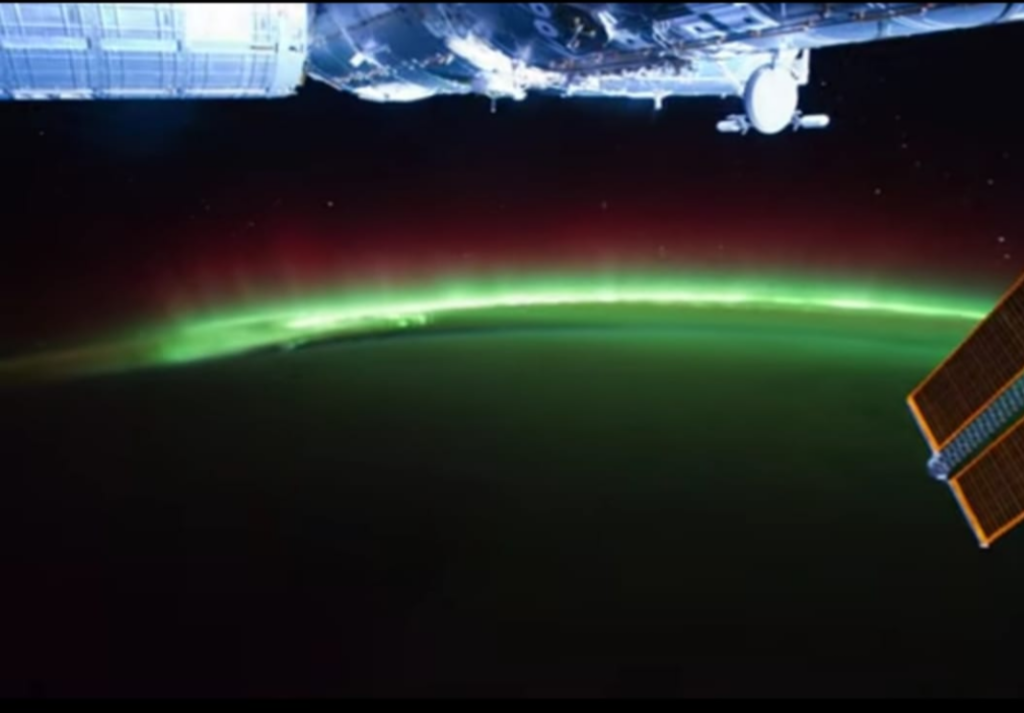
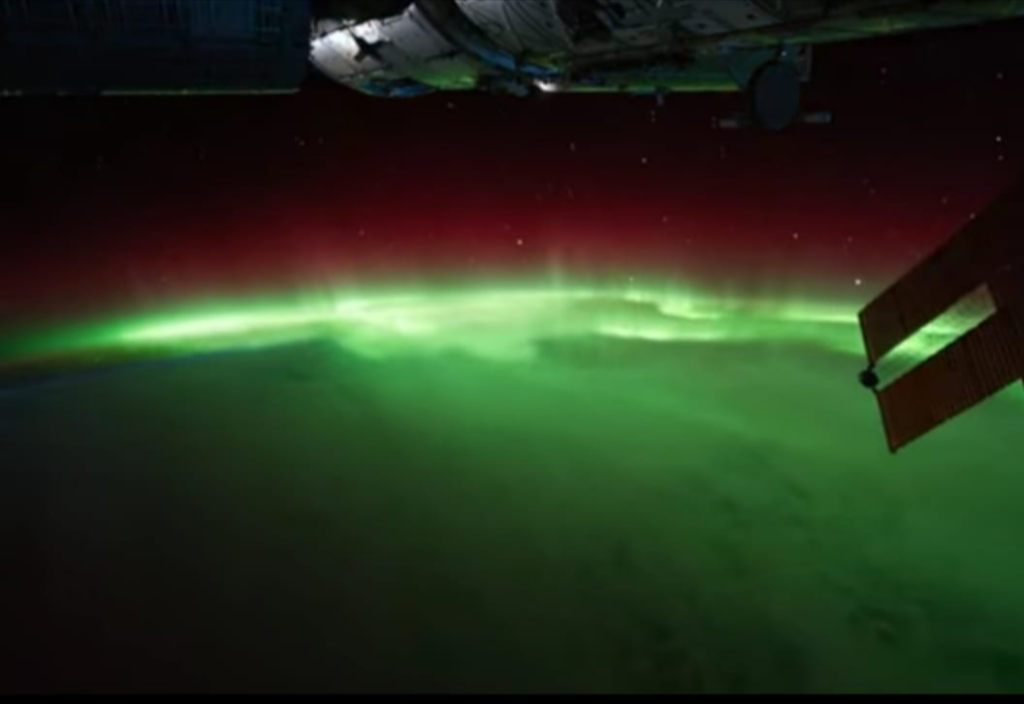
This sequence of shots was taken 17 September 2011 from 17:22:27 to 17:45:12 GMT, on an ascending pass from south of Madagascar to just north of Australia over the Indian Ocean.
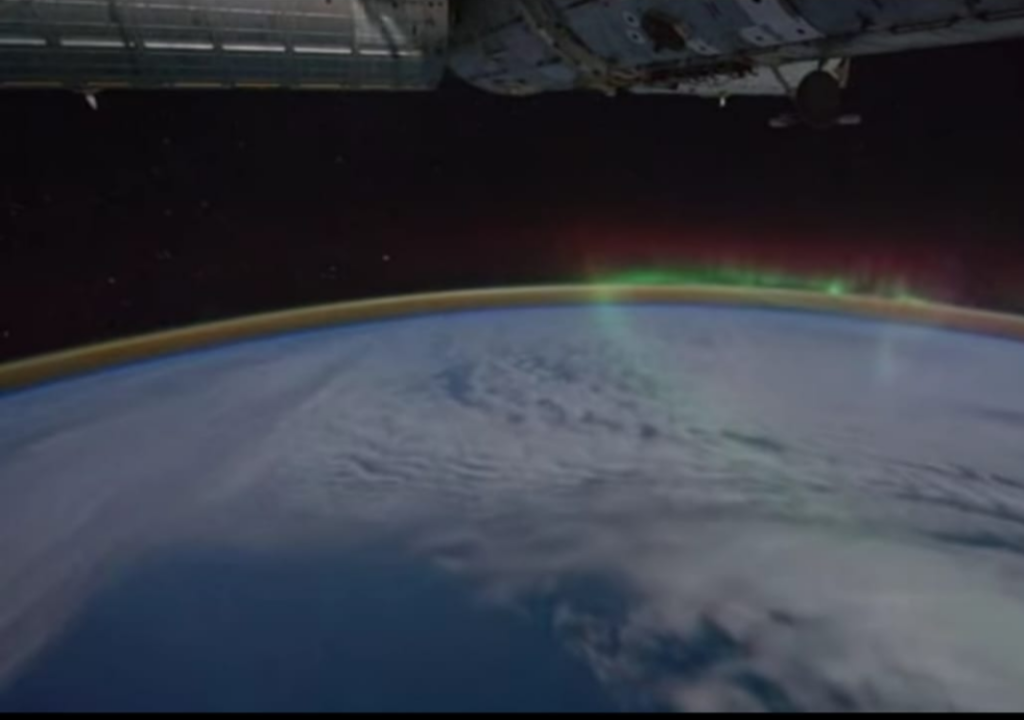
Photos taken on 7th. September 2011, from 17:38:03 to 17:49:15 GMT, from the French Southern and Antarctic Lands in the South Indian Ocean to southern Australia.
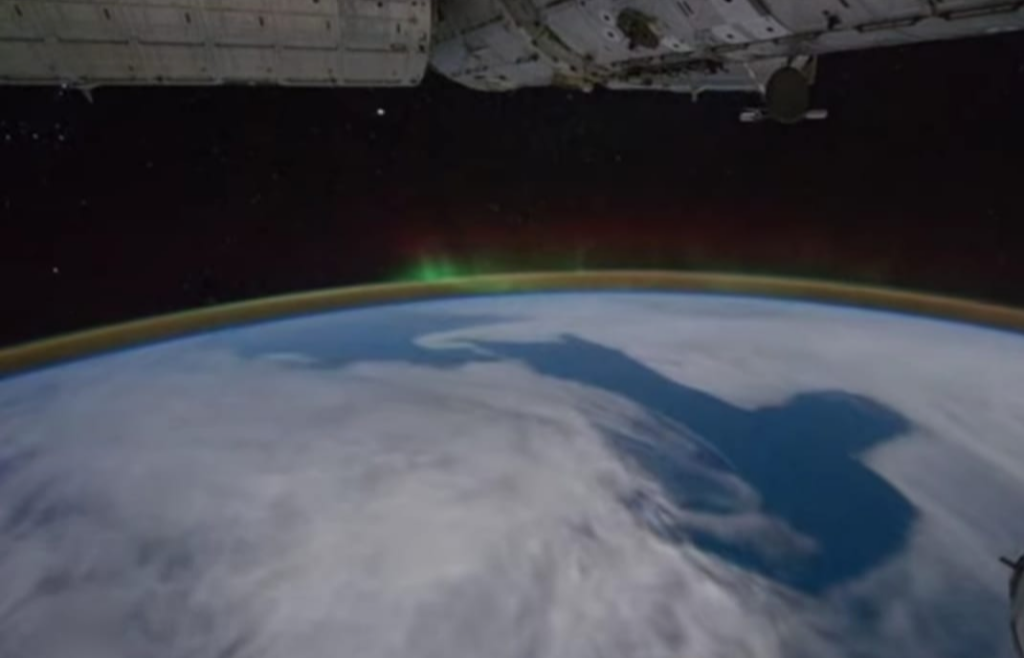
XXXXXXXXXX
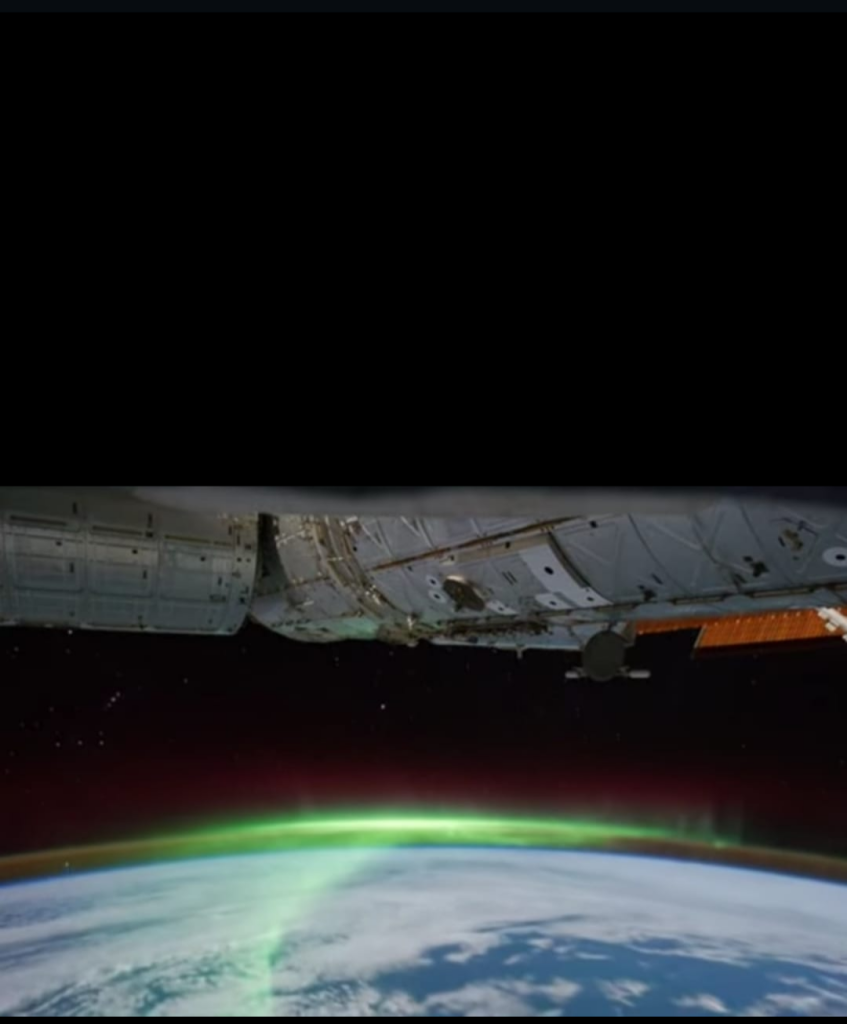
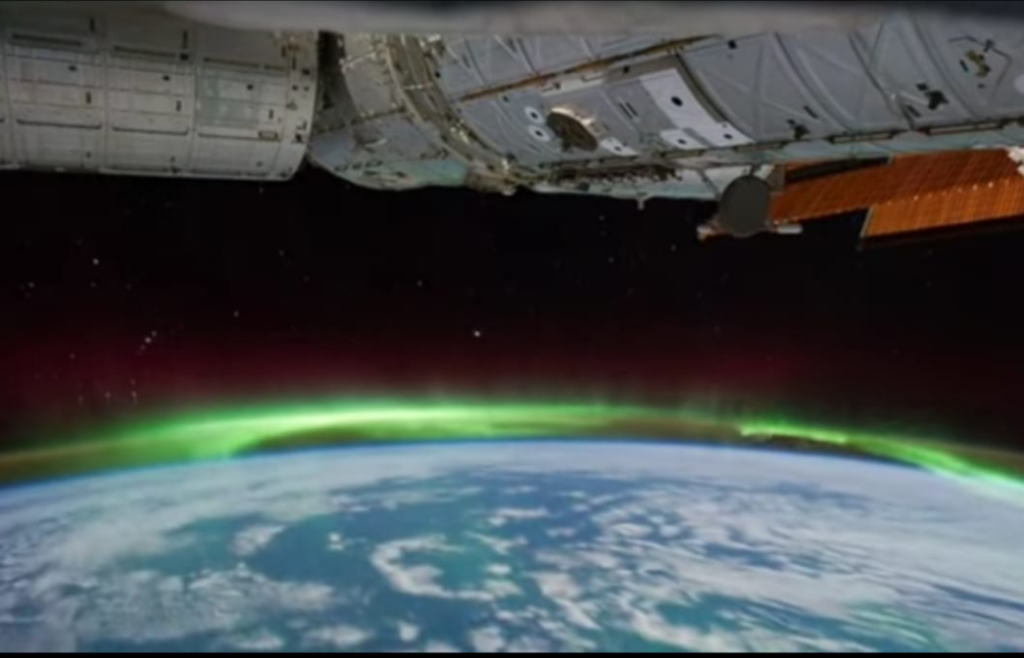
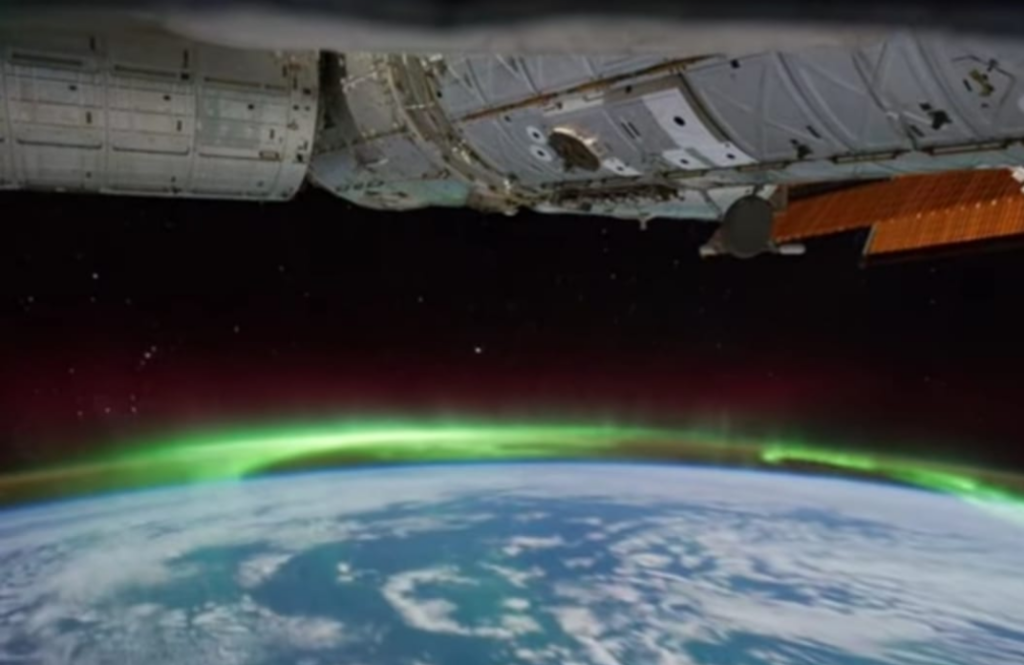
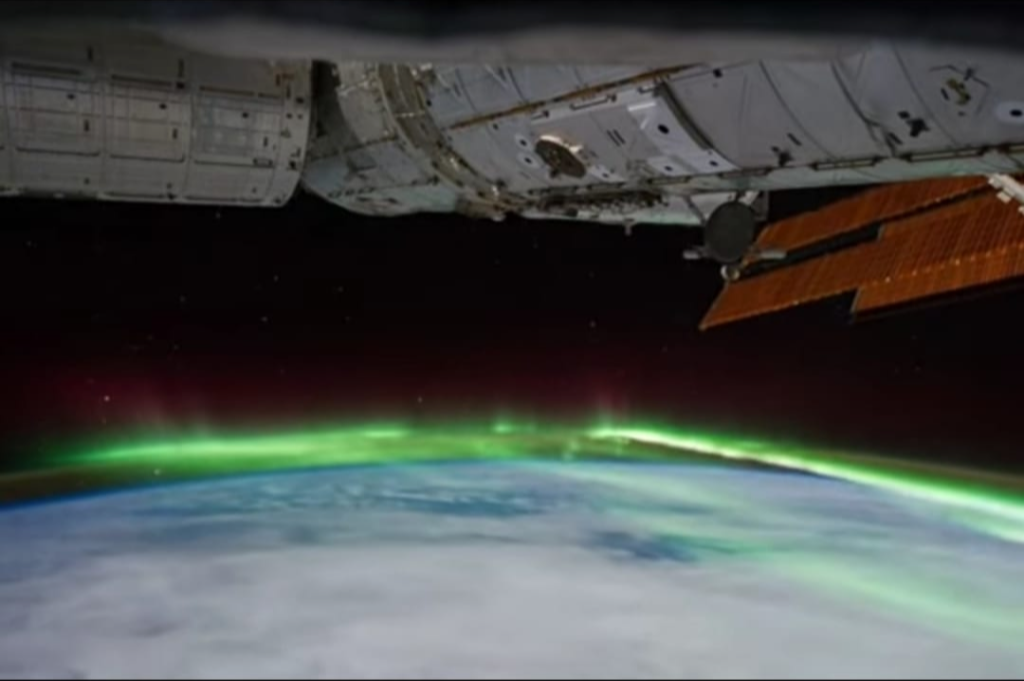
These sequences of shots were taken on 11th. September, 2011 from 13:45:06 to 14:01:51 GMT, from a descending pass near eastern Australia, rounding about to an ascending pass to the east of New Zealand.
Auroras are occasionally seen in latitudes below the auroral zone, when a geomagnetic storm temporarily enlarges the auroral oval. Large geomagnetic storms are most common during the peak of the 11-year sunspot cycle or during the three years after the peak.
An electron spirals (gyrates) about a field line at an angle that is determined by its velocity vectors, parallel and perpendicular, respectively, to the local geomagnetic field vector B. This angle is known as the “pitch angle” of the particle.
The distance, or radius, of the electron from the field line at any time is known as its Larmor radius. The pitch angle increases as the electron travels to a region of greater field strength nearer to the atmosphere. Thus, it is possible for some particles to return, or mirror, if the angle becomes 90° before entering the atmosphere to collide with the denser molecules there.
Other particles that do not mirror enter the atmosphere and contribute to the auroral display over a range of altitudes. Other types of auroras have been observed from space; for example, “poleward arcs” stretching sunward across the polar cap, the related “theta aurora”, and “dayside arcs” near noon. These are relatively infrequent and poorly understood.
Other interesting effects occur such as flickering aurora, “black aurora” and subvisual red arcs. In addition to all these, a weak glow (often deep red) observed around the two polar cusps, the field lines separating the ones that close through Earth from those that are swept into the tail and close remotely.
Images.
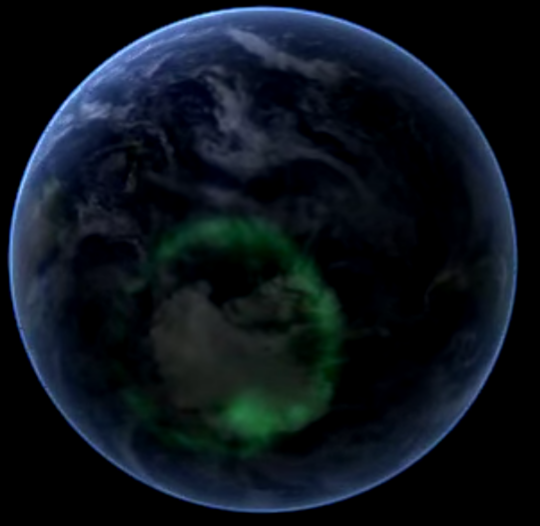
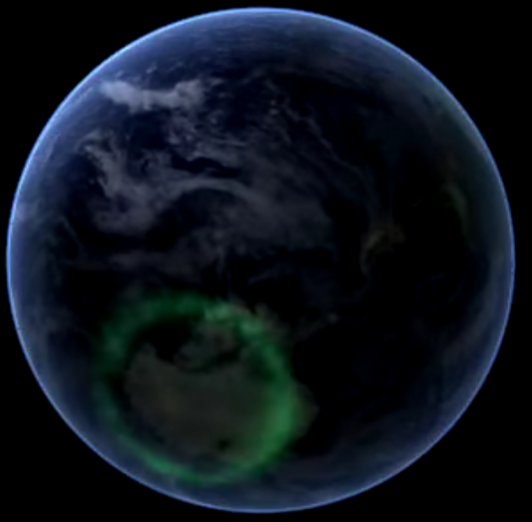
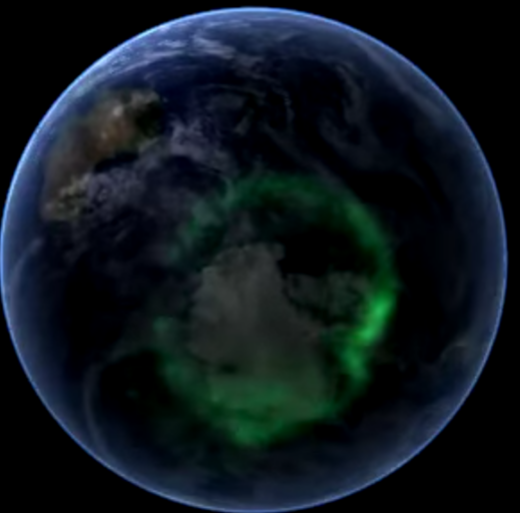
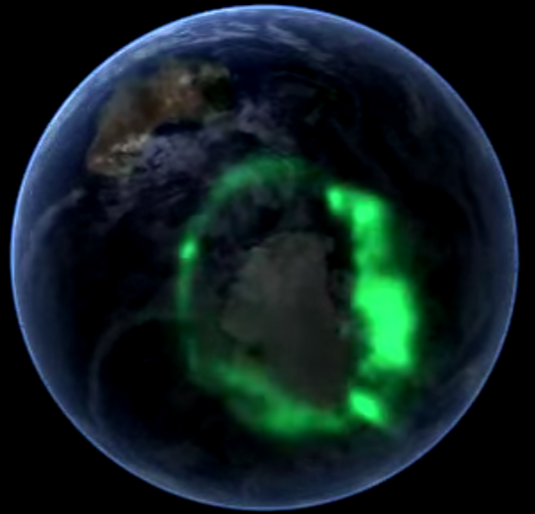
Photographs taken from video of the complete aurora australis by IMAGE, superimposed over a digital image of Earth.
.
Early work on the imaging of the auroras was done in 1949 by the University of Saskatchewan using the SCR-270 radar.[citation needed] The altitudes where auroral emissions occur were revealed by Carl Størmer and his colleagues, who used cameras to triangulate more than 12,000 auroras. They discovered that most of the light is produced between 90 km (56 mi) and 150 km (93 mi) above the ground, while extending at times to more than 1000 km (620 mi).
Forms.
According to Clark (2007), there are four main forms that can be seen from the ground, from least to most visible.
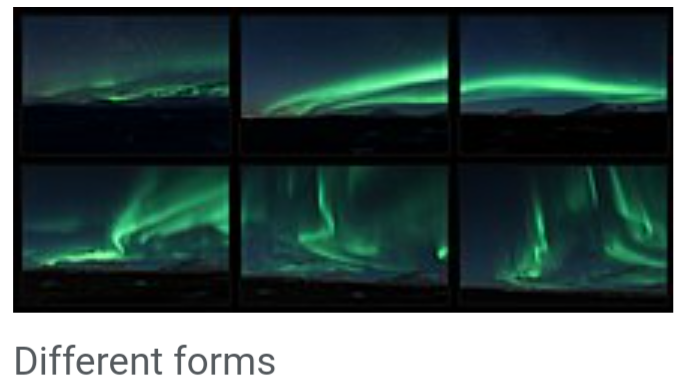
A mild glow, near the horizon. These can be close to the limit of visibility,[20] but can be distinguished from moonlit clouds because stars can be seen undiminished through the glow.
Patches or surfaces that look like clouds.
Arcs curve across the sky.
Rays are light and dark stripes across arcs, reaching upwards by various amounts.
Coronas cover much of the sky and diverge from one point on it.
Brekke (1994) also described some auroras as curtains. The similarity to curtains is often enhanced by folds within the arcs. Arcs can fragment or break up into separate, at times rapidly changing, often rayed features that may fill the whole sky. These are also known as discrete auroras, which are at times bright enough to read a newspaper by at night.
These forms are consistent with auroras being shaped by Earth’s magnetic field. The appearances of arcs, rays, curtains, and coronas are determined by the shapes of the luminous parts of the atmosphere and a viewer’s position.
Colors and Wavelengths of Auroral Light.
Red: At its highest altitudes, excited atomic oxygen emits at 630 nm (red); low concentration of atoms and lower sensitivity of eyes at this wavelength make this color visible only under more intense solar activity. The low number of oxygen atoms and their gradually diminishing concentration is responsible for the faint appearance of the top parts of the “curtains”. Scarlet, crimson, and carmine are the most often-seen hues of red for the auroras.
Green: At lower altitudes, the more frequent collisions suppress the 630 nm (red) mode: rather the 557.7 nm emission (green) dominates. A fairly high concentration of atomic oxygen and higher eye sensitivity in green make green auroras the most common. The excited molecular nitrogen (atomic nitrogen being rare due to the high stability of the N2 molecule) plays a role here, as it can transfer energy by collision to an oxygen atom, which then radiates it away at the green wavelength. (Red and green can also mix together to produce pink or yellow hues.) The rapid decrease of concentration of atomic oxygen below about 100 km is responsible for the abrupt-looking end of the lower edges of the curtains. Both the 557.7 and 630.0 nm wavelengths correspond to forbidden transitions of atomic oxygen, a slow mechanism responsible for the graduality (0.7 s and 107 s respectively) of flaring and fading.
Blue: At yet lower altitudes, atomic oxygen is uncommon, and molecular nitrogen and ionized molecular nitrogen take over in producing visible light emission, radiating at a large number of wavelengths in both red and blue parts of the spectrum, with 428 nm (blue) being dominant. Blue and purple emissions, typically at the lower edges of the “curtains”, show up at the highest levels of solar activity. The molecular nitrogen transitions are much faster than the atomic oxygen ones.
Ultraviolet radiation from auroras (within the optical window but not visible to virtually all[clarification needed] humans) has been observed with the requisite equipment. Ultraviolet auroras have also been seen on Mars, Jupiter and Saturn.
Infrared radiation, in wavelengths that are within the optical window, is also part of many auroras.
Yellow and pink are a mix of red and green or blue. Other shades of red, as well as orange, may be seen on rare occasions; yellow-green is moderately common.[clarification needed] As red, green, and blue are linearly independent colors, additive synthesis could, in theory, produce most human-perceived colors, but the ones mentioned in this article comprise a virtually exhaustive list.
Changes with Time.
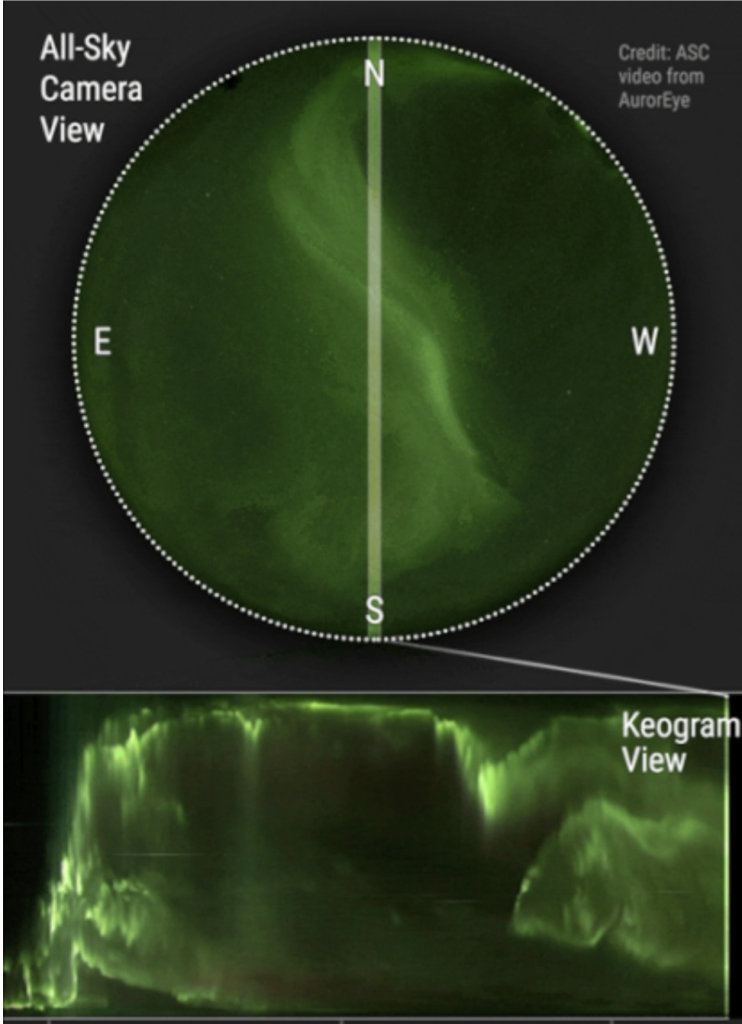
This animation illustrates the construction of a keogram. Keogram image generated from the center column of pixels of 997 sequential RGB images using author’s software. Each image was a 2 second exposure. Captured at Midnight Dome, Dawson City (Lat 64.067, Long -139.396), on the night of September 6/7, 2021 using an AurorEye portable all-sky imaging camera.
Compressed vertically from a 4000px to 240px height.
Date, 7 September 2021. Author, Jeremy Kuzub.
Construction of a keogram from one night’s recording by an all-sky camera, 6/7 September 2021. Keograms are commonly used to visualize changes in aurorae over time.
Auroras change with time. Over the night, they begin with glows and progress towards coronas, although they may not reach them. They tend to fade in the opposite order. Until about 1963 it was thought that these changes are due to the rotation of the Earth under a pattern fixed with respect to the Sun. Later it was found by comparing all-sky films of auroras from different places (collected during the International Geophysical Year) that they often undergo global changes in a process called auroral substorm. They change in a few minutes from quiet arcs all along the auroral oval to active displays along the darkside and after 1 – 3 hours they gradually change back. Changes in auroras over time are commonly visualized using keograms.
At shorter time scales, auroras can change their appearances and intensity, sometimes so slowly as to be difficult to notice, and at other times rapidly down to the sub-second scale. The phenomenon of pulsating auroras is an example of intensity variations over short timescales, typically with periods of 2–20 seconds. This type of aurora is generally accompanied by decreasing peak emission heights of about 8 km for blue and green emissions and above average solar wind speeds (~ 500 km/s).
Other Auroral Radiation.
In addition, the aurora and associated currents produce a strong radio emission around 150 kHz known as auroral kilometric radiation (AKR), discovered in 1972. Ionospheric absorption makes AKR only observable from space. X-ray emissions, originating from the particles associated with auroras, have also been detected.
Noise.
Aurora noise, similar to a crackling noise, begins about 70 m (230 ft) above Earth’s surface and is caused by charged particles in an inversion layer of the atmosphere formed during a cold night. The charged particles discharge when particles from the Sun hit the inversion layer, creating the noise.
Unusual Types.
STEVE.
In 2016, more than fifty citizen science observations described what was to them an unknown type of aurora which they named “STEVE”, for “Strong Thermal Emission Velocity Enhancement”. STEVE is not an aurora but is caused by a 25 km (16 mi) wide ribbon of hot plasma at an altitude of 450 km (280 mi), with a temperature of 6,000 K (5,730 °C; 10,340 °F) and flowing at a speed of 6 km/s (3.7 mi/s) (compared to 10 m/s (33 ft/s) outside the ribbon).
Picket Fence Aurora.
The processes that cause STEVE also are associated with a picket-fence aurora, although the latter can be seen without STEVE. It is an aurora because it is caused by precipitation of electrons in the atmosphere but it appears outside the auroral oval, closer to the equator than typical auroras. When the picket-fence aurora appears with STEVE, it is below.
Dune aurora
First reported in 2020 and confirmed in 2021 the dune aurora phenomenon was discovered[43] by Finnish citizen scientists. It consists of regularly-spaced, parallel stripes of brighter emission in the green diffuse aurora which give the impression of sand dunes. The phenomenon is believed to be caused by the modulation of atomic oxygen density by a large-scale atmospheric wave travelling horizontally in a waveguide through an inversion layer in the mesosphere in presence of electron precipitation.
Causes. A full understanding of the physical processes which lead to different types of auroras is still incomplete, but the basic cause involves the interaction of the solar wind with Earth’s magnetosphere. The varying intensity of the solar wind produces effects of different magnitudes but includes one or more of the following physical scenarios.
A quiescent solar wind flowing past Earth’s magnetosphere steadily interacts with it and can both inject solar wind particles directly onto the geomagnetic field lines that are ‘open’, as opposed to being ‘closed’ in the opposite hemisphere, and provide diffusion through the bow shock. It can also cause particles already trapped in the radiation belts to precipitate into the atmosphere. Once particles are lost to the atmosphere from the radiation belts, under quiet conditions, new ones replace them only slowly, and the loss-cone becomes depleted. In the magnetotail, however, particle trajectories seem constantly to reshuffle, probably when the particles cross the very weak magnetic field near the equator.
As a result, the flow of electrons in that region is nearly the same in all directions (“isotropic”) and assures a steady supply of leaking electrons. The leakage of electrons does not leave the tail positively charged, because each leaked electron lost to the atmosphere is replaced by a low energy electron drawn upward from the ionosphere. Such replacement of “hot” electrons by “cold” ones is in complete accord with the second law of thermodynamics. The complete process, which also generates an electric ring current around Earth, is uncertain.
Geomagnetic disturbance from an enhanced solar wind causes distortions of the magnetotail (“magnetic substorms”).
These ‘substorms’ tend to occur after prolonged spells (on the order of hours) during which the interplanetary magnetic field has had an appreciable southward component. This leads to a higher rate of interconnection between its field lines and those of Earth. As a result, the solar wind moves magnetic flux (tubes of magnetic field lines, ‘locked’ together with their resident plasma) from the day side of Earth to the magnetotail, widening the obstacle it presents to the solar wind flow and constricting the tail on the night-side.
Ultimately some tail plasma can separate (“magnetic reconnection”); some blobs (“plasmoids”) are squeezed downstream and are carried away with the solar wind; others are squeezed toward Earth where their motion feeds strong outbursts of auroras, mainly around midnight (“unloading process”). A geomagnetic storm resulting from greater interaction adds many more particles to the plasma trapped around Earth, also producing enhancement of the “ring current”. Occasionally the resulting modification of Earth’s magnetic field can be so strong that it produces auroras visible at middle latitudes, on field lines much closer to the equator than those of the auroral zone.
Moon and Aurora
Acceleration of auroral charged particles invariably accompanies a magnetospheric disturbance that causes an aurora. This mechanism, which is believed to predominantly arise from strong electric fields along the magnetic field or wave-particle interactions, raises the velocity of a particle in the direction of the guiding magnetic field. The pitch angle is thereby decreased and increases the chance of it being precipitated into the atmosphere. Both electromagnetic and electrostatic waves, produced at the time of greater geomagnetic disturbances, make a significant contribution to the energizing processes that sustain an aurora. Particle acceleration provides a complex intermediate process for transferring energy from the solar wind indirectly into the atmosphere.
The details of these phenomena are not fully understood. However, it is clear that the prime source of auroral particles is the solar wind feeding the magnetosphere, the reservoir containing the radiation zones and temporarily magnetically-trapped particles confined by the geomagnetic field, coupled with particle acceleration processes.
Auroral particles.
The immediate cause of the ionization and excitation of atmospheric constituents leading to auroral emissions was discovered in 1960, when a pioneering rocket flight from Fort Churchill in Canada revealed a flux of electrons entering the atmosphere from above. Since then an extensive collection of measurements has been acquired painstakingly and with steadily improving resolution since the 1960s by many research teams using rockets and satellites to traverse the auroral zone. The main findings have been that auroral arcs and other bright forms are due to electrons that have been accelerated during the final few 10,000 km or so of their plunge into the atmosphere.
These electrons often, but not always, exhibit a peak in their energy distribution, and are preferentially aligned along the local direction of the magnetic field.
Electrons mainly responsible for diffuse and pulsating auroras have, in contrast, a smoothly falling energy distribution, and an angular (pitch-angle) distribution favouring directions perpendicular to the local magnetic field. Pulsations were discovered to originate at or close to the equatorial crossing point of auroral zone magnetic field lines. Protons are also associated with auroras, both discrete and diffuse.
Atmosphere
Auroras result from emissions of photons in Earth’s upper atmosphere, above 80 km (50 mi), from ionized nitrogen atoms regaining an electron, and oxygen atoms and nitrogen based molecules returning from an excited state to ground state.
They are ionized or excited by the collision of particles precipitated into the atmosphere. Both incoming electrons and protons may be involved. Excitation energy is lost within the atmosphere by the emission of a photon, or by collision with another atom or molecule:
Oxygen emissionsgreen or orange-red, depending on the amount of energy absorbed.Nitrogen emissionsblue, purple or red; blue and purple if the molecule regains an electron after it has been ionized, red if returning to ground state from an excited state.
Oxygen is unusual in terms of its return to ground state: it can take 0.7 seconds to emit the 557.7 nm green light and up to two minutes for the red 630.0 nm emission.
Collisions with other atoms or molecules absorb the excitation energy and prevent emission, this process is called collisional quenching. Because the highest parts of the atmosphere contain a higher percentage of oxygen and lower particle densities, such collisions are rare enough to allow time for oxygen to emit red light. Collisions become more frequent progressing down into the atmosphere due to increasing density, so that red emissions do not have time to happen, and eventually, even green light emissions are prevented.
This is why there is a color differential with altitude; at high altitudes oxygen red dominates, then oxygen green and nitrogen blue/purple/red, then finally nitrogen blue/purple/red when collisions prevent oxygen from emitting anything. Green is the most common color. Then comes pink, a mixture of light green and red, followed by pure red, then yellow (a mixture of red and green), and finally, pure blue.
Precipitating protons generally produce optical emissions as incident hydrogen atoms after gaining electrons from the atmosphere. Proton auroras are usually observed at lower latitudes.
Ionosphere.
Bright auroras are generally associated with Birkeland currents (Schield et al., 1969; Zmuda and Armstrong, 1973, which flow down into the ionosphere on one side of the pole and out on the other.
In between, some of the current connects directly through the ionospheric E layer (125 km); the rest (“region 2”) detours, leaving again through field lines closer to the equator and closing through the “partial ring current” carried by magnetically trapped plasma. The ionosphere is an ohmic conductor, so some consider that such currents require a driving voltage, which an, as yet unspecified, dynamo mechanism can supply. Electric field probes in orbit above the polar cap suggest voltages of the order of 40,000 volts, rising up to more than 200,000 volts during intense magnetic storms. In another interpretation, the currents are the direct result of electron acceleration into the atmosphere by wave/particle interactions.
Ionospheric resistance has a complex nature, and leads to a secondary Hall current flow.
By a strange twist of physics, the magnetic disturbance on the ground due to the main current almost cancels out, so most of the observed effect of auroras is due to a secondary current, the auroral electrojet. An auroral electrojet index (measured in nanotesla) is regularly derived from ground data and serves as a general measure of auroral activity. Kristian Birkeland deduced that the currents flowed in the east–west directions along the auroral arc, and such currents, flowing from the dayside toward (approximately) midnight were later named “auroral electrojets”
Courtesy, Wikipedia. CC BY – SA 3.0 unless otherwise noted.

